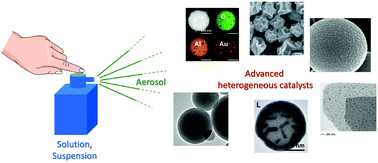当前位置:
X-MOL 学术
›
Chem. Soc. Rev.
›
论文详情
Our official English website, www.x-mol.net, welcomes your
feedback! (Note: you will need to create a separate account there.)
Aerosol processing: a wind of innovation in the field of advanced heterogeneous catalysts
Chemical Society Reviews ( IF 40.4 ) Pub Date : 2018-04-16 00:00:00 , DOI: 10.1039/c7cs00697g Damien P. Debecker 1, 2, 3, 4 , Solène Le Bras 1, 2, 3, 4 , Cédric Boissière 5, 6, 7, 8, 9 , Alexandra Chaumonnot 10, 11, 12, 13 , Clément Sanchez 5, 6, 7, 8, 9
Chemical Society Reviews ( IF 40.4 ) Pub Date : 2018-04-16 00:00:00 , DOI: 10.1039/c7cs00697g Damien P. Debecker 1, 2, 3, 4 , Solène Le Bras 1, 2, 3, 4 , Cédric Boissière 5, 6, 7, 8, 9 , Alexandra Chaumonnot 10, 11, 12, 13 , Clément Sanchez 5, 6, 7, 8, 9
Affiliation

|
Aerosol processing is long known and implemented industrially to obtain various types of divided materials and nanomaterials. The atomisation of a liquid solution or suspension produces a mist of aerosol droplets which can then be transformed via a diversity of processes including spray-drying, spray pyrolysis, flame spray pyrolysis, thermal decomposition, micronisation, gas atomisation, etc. The attractive technical features of these aerosol processes make them highly interesting for the continuous, large scale, and tailored production of heterogeneous catalysts. Indeed, during aerosol processing, each liquid droplet undergoes well-controlled physical and chemical transformations, allowing for example to dry and aggregate pre-existing solid particles or to synthesise new micro- or nanoparticles from mixtures of molecular or colloidal precursors. In the last two decades, more advanced reactive aerosol processes have emerged as innovative means to synthesise tailored-made nanomaterials with tunable surface properties, textures, compositions, etc. In particular, the “aerosol-assisted sol–gel” process (AASG) has demonstrated tremendous potential for the preparation of high-performance heterogeneous catalysts. The method is mainly based on the low-cost, scalable, and environmentally benign sol–gel chemistry process, often coupled with the evaporation-induced self-assembly (EISA) concept. It allows producing micronic or submicronic, inorganic or hybrid organic–inorganic particles bearing tuneable and calibrated porous structures at different scales. In addition, pre-formed nanoparticles can be easily incorporated or formed in a “one-pot” bottom-up approach within the porous inorganic or hybrid spheres produced by such spray drying method. Thus, multifunctional catalysts with tailored catalytic activities can be prepared in a relatively simple way. This account is an overview of aerosol processed heterogeneous catalysts which demonstrated interesting performance in various relevant chemical reactions like isomerisation, hydrogenation, olefin metathesis, pollutant total oxidation, selective oxidation, CO2 methanation, etc. A short survey of patents and industrial applications is also presented. Our objective is to demonstrate the tremendous possibilities offered by the coupling between bottom up synthesis routes and these aerosol processing technologies which will most probably represent a major route of innovation in the mushrooming field of catalyst preparation research.
中文翻译:

气雾剂加工:先进多相催化剂领域的创新之风
气雾剂处理是众所周知的,并在工业上用于获得各种类型的分离材料和纳米材料。液体溶液或悬浮液的雾化会产生气雾滴,然后可以通过多种过程进行转化,这些过程包括喷雾干燥,喷雾热解,火焰喷雾热解,热分解,微粉化,气体雾化等。这些气雾剂工艺的吸引人的技术特征使其对于连续,大规模和量身定制的非均相催化剂的生产引起了极大的兴趣。实际上,在气雾剂处理过程中,每个液滴都会受到良好控制的物理和化学转变,例如可以干燥和聚集预先存在的固体颗粒,或者从分子或胶体前体的混合物中合成新的微米或纳米颗粒。在过去的二十年中,更先进的反应性气溶胶工艺作为合成具有可调整的表面特性,质地,组成等的量身定制的纳米材料的创新手段而出现。特别是,“气溶胶辅助溶胶-凝胶”工艺(AASG)已证明在制备高性能多相催化剂方面具有巨大潜力。该方法主要基于低成本,可扩展且对环境无害的溶胶-凝胶化学工艺,通常结合蒸发诱导自组装(EISA)概念。它允许生产微米级或亚微米级,无机或杂化的有机-无机颗粒,它们具有不同规模的可调谐和校准的多孔结构。另外,预先形成的纳米颗粒可以容易地以“一锅”自下而上的方式掺入或形成在通过这种喷雾干燥方法生产的多孔无机或杂化球体中。因此,可以以相对简单的方式制备具有定制催化活性的多功能催化剂。2甲烷化等。还介绍了专利和工业应用的简短调查。我们的目标是证明自下而上的合成路线与这些气溶胶处理技术之间的耦合所提供的巨大可能性,这很可能代表了催化剂制备研究迅速发展的领域中的主要创新路线。
更新日期:2018-04-16
中文翻译:

气雾剂加工:先进多相催化剂领域的创新之风
气雾剂处理是众所周知的,并在工业上用于获得各种类型的分离材料和纳米材料。液体溶液或悬浮液的雾化会产生气雾滴,然后可以通过多种过程进行转化,这些过程包括喷雾干燥,喷雾热解,火焰喷雾热解,热分解,微粉化,气体雾化等。这些气雾剂工艺的吸引人的技术特征使其对于连续,大规模和量身定制的非均相催化剂的生产引起了极大的兴趣。实际上,在气雾剂处理过程中,每个液滴都会受到良好控制的物理和化学转变,例如可以干燥和聚集预先存在的固体颗粒,或者从分子或胶体前体的混合物中合成新的微米或纳米颗粒。在过去的二十年中,更先进的反应性气溶胶工艺作为合成具有可调整的表面特性,质地,组成等的量身定制的纳米材料的创新手段而出现。特别是,“气溶胶辅助溶胶-凝胶”工艺(AASG)已证明在制备高性能多相催化剂方面具有巨大潜力。该方法主要基于低成本,可扩展且对环境无害的溶胶-凝胶化学工艺,通常结合蒸发诱导自组装(EISA)概念。它允许生产微米级或亚微米级,无机或杂化的有机-无机颗粒,它们具有不同规模的可调谐和校准的多孔结构。另外,预先形成的纳米颗粒可以容易地以“一锅”自下而上的方式掺入或形成在通过这种喷雾干燥方法生产的多孔无机或杂化球体中。因此,可以以相对简单的方式制备具有定制催化活性的多功能催化剂。2甲烷化等。还介绍了专利和工业应用的简短调查。我们的目标是证明自下而上的合成路线与这些气溶胶处理技术之间的耦合所提供的巨大可能性,这很可能代表了催化剂制备研究迅速发展的领域中的主要创新路线。











































 京公网安备 11010802027423号
京公网安备 11010802027423号